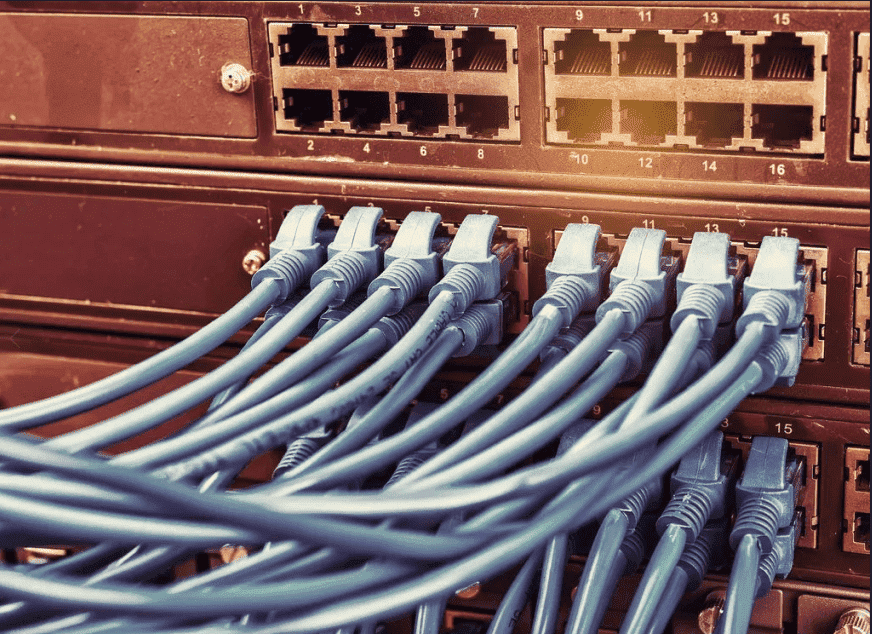Due to the high requirements of the industrial environment for the reliability of industrial control networks, the redundant functions of Industrial Ethernet have emerged. From rapid spanning tree redundancy (RSTP), ring redundancy (RapidRing) to backbone redundancy (relay), each has its own advantages and characteristics, and control engineers can choose according to their own requirements. In order to better understand and learn the characteristics of Industrial Ethernet redundancy technology, let us first review the development process of the following Ethernet devices.
1, hub
I believe most people are familiar with hubs. Many people use this simple device to connect various Ethernet-based devices, such as personal computers, programmable controllers, and so on. The hub receives a message from a port and broadcasts the message to all other ports.
For every message from any port, the hub will pass it to other ports. In terms of messaging, the hub is slow and inefficient, and message collisions may occur. However, the use of the hub is very simple. It can actually be plug and play. The hub does not have any flashy features and no redundancy.
2, unmanaged switches
The development of hubs has resulted in a device called an unmanaged switch. It enables routing of messages from one port to another, making them more intelligent than hubs. Unmanaged switches automatically detect the network speed of each network device. In addition, it has a function called "MAC Address Table" that identifies and remembers devices on the network.
In other words, if port 2 receives a message with a specific identification code, then the switch will send all messages with that specific identification code to port 2, this intelligence avoids message collisions and improves transmission performance. It was a huge improvement. However, unmanaged switches cannot implement any form of communication detection and redundancy configuration.
3, managed switches
The next generation of Ethernet connectivity devices is managed switches versus hubs and unmanaged switches. Managed switches have more and more complex features and are much more expensive - usually 3 to 4 of an unmanaged switch. Times. Managed switches provide more functionality and are typically fully configurable through a network-based interface. It can automatically interact with network devices, and users can manually configure network speed and flow control for each port. Some old devices may not be able to use the automatic interaction feature, so manual configuration is indispensable.
Most managed switches also typically provide advanced features such as SNMP for remote monitoring and configuration (Simple Network Management Protocol), port mapping for diagnostics, VLANs for network device grouping (virtual local area network), The priority ranking function for ensuring the passage of priority messages, and so on. With a managed switch, you can set up a redundant network. With a ring topology, managed switches can form a ring network. Each managed switch can automatically determine the optimal transmission path and the alternate path, and automatically block the alternate path when the priority path is interrupted.
As shown in Figure 4, the managed redundant switch
Advanced managed redundant switches offer special features, especially for redundant systems with strict stability and security requirements. The main ways to build a redundant network are as follows: STP, RSTP; Ring Redundancy RapidRing
STP and RSTP
STP (Spanning Tree Algorithm, Spanning Tree Algorithm, IEEE 802.1D) is a link layer protocol that provides path redundancy and prevents network loops from occurring. It forces the alternate data path to be blocked (blocked). If a path fails, the topology can be reconfigured and link reconfigured by activating the alternate path. The network interrupt recovery time is between 30~60s. The fast spanning tree algorithm, IEEE 802.1w as an STP upgrade, reduces the network interrupt recovery time to 1 to 2 seconds. The spanning tree algorithm has a flexible network structure, but it also has the disadvantage of slow recovery.
Ring Redundancy RapidRing
In order to meet the real-time characteristics of industrial control networks, RapidRing was born. This is a technique that uses ring networks to provide high-speed redundancy in Ethernet networks. This technology allows the network to recover itself within 300 milliseconds of the interruption. And through the switch's error relay connection, status display lights and SNMP settings, etc. to remind users of the phenomenon of network disconnection. These can help diagnose where the ring is broken.
RapidRing also supports two ring networks that are connected together to make the network topology more flexible. The two rings are connected by two channels, which can be redundant to avoid problems caused by single cable errors.
Trunk redundant cluster
By setting up multiple ports of different switches as trunk trunk ports and establishing connections, a high-speed backbone link can be formed between these switches. Not only has it doubled the network bandwidth of the backbone link, it has enhanced network throughput, but it also provides another feature, redundancy.
If the backbone link in the network has problems such as disconnection, the data in the network will be transmitted through the remaining links to ensure the normal communication of the network. The trunking backbone network adopts the bus type and the star network structure, and the theoretical communication distance can be extended indefinitely. . This technology uses a hardware detection and data balance method, so the network interrupt recovery time has reached a new height, the general recovery time is below 10 milliseconds.
For more study materials from IT Certification exam, tips and news, you can subscribe SPOTO.

 Join Telegram Study Group ▷
Join Telegram Study Group ▷













